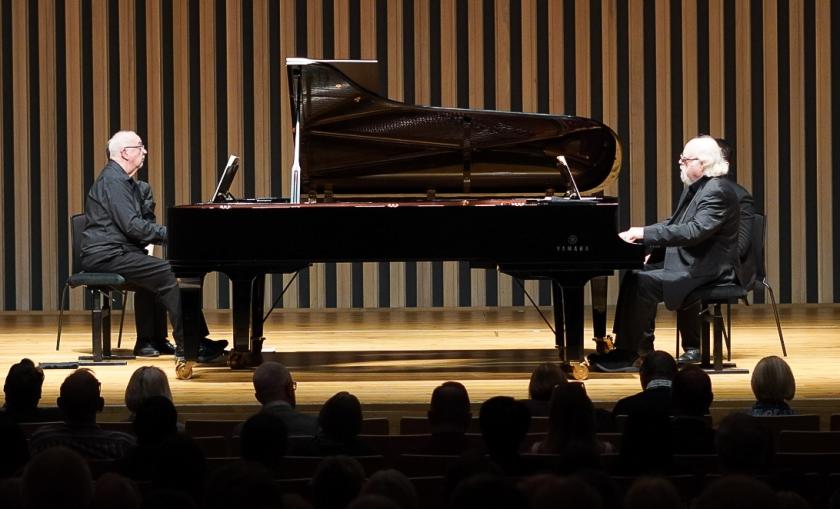A little piece of musical history was made last night at Manchester Chamber Concerts Society’s season-opening concert. Two of the greatest pianists of their generation, who met at the Royal Northern College of Music, celebrated the 50th anniversary of their first collaboration there.
Peter Donohoe and Martin Roscoe played duets for two pianos: they’ve done it throughout their careers, and in Donohoe’s case with other celebrated partners. But there was a special chemistry between the two old friends that made for a magical evening.
Their first appearance on the same platform was actually slightly longer ago, when Martin Roscoe was solo pianist and Peter Donohoe occupied the role of timpanist in the RNCM orchestra (I remember him well from that time – slim in build, with some blond hair on the top of his head, and the beard just a modest goatee on his chin: a friend whispered to me that the guy was not a bad piano player, either).
For their golden jubilee together Roscoe and Donohoe chose a programme of music specifically written for the two-piano medium – not arrangements of orchestral scores – and who knew better how to do it than Mozart, in the Sonata in D (K448)? It’s a witty demonstration of inter-weaving lines and shared textures, needing absolute precision and co-ordination. For much of the time, not surprisingly, tempo has to be unbending, but nonetheless these two achieved unanimous shaping of their phrases and even a few nuances of rhythm where Mozart considerately provides for them. The slow movement’s section-ending trills were in elegant sync, and the finale was an exhilarating feast of scurrying notes adorned by moments of unexpected delight.
I’m always intrigued by the near-miraculous telepathy that’s required for this kind of piano duetting. Two pianists playing two pianos almost always face each other and neither can see their partner’s hands, which means a nod of the head or flicker of an eyebrow are the only visual connection they can have. This is where a recital of this kind stands or falls – I’ve heard examples where the players almost totally failed to land a shared chord exactly together. But Roscoe and Donohoe do it perfectly all the time (or with only the very, very tiniest imprecisions, and those only very rarely). You have to think inside your partner’s mind to achieve that.
Saint-Saëns’ Variations on a Theme of Beethoven (in fact on the scherzo tune from the Sonata in E flat, op.31 no.3) sounds at times like an extension of Le Carnaval des animaux, announcing the theme with lumbering chords and sforzandi and later bringing a mock-sentimental grazioso and mock-lugubrious funeral march, but it builds through a colossal crescendo to its climax (and then a comic close), and the dry, Lancastrian humour which is apparent whenever either of these performers gets a microphone in his hand was there in the playing: I guess the style appealed to them mightily.
Debussy’s En blanc et noir, coming after the break, was very different. Written during the First World War, its central “Lent, sombre” Is a meditation on the carnage with a modal flavour and textures not a million miles away from Vaughan Williams’ Tallis Fantasia. The playing was deeply thoughtful, almost graphic in its grumbling, rumbling distortions of the chorale melody Ein Feste Burg, and with a shattering final explosion. The poetry and grotesquerie of the opening section and the chilling clarity of the final one – far from the impressionistic colour-wash of earlier Debussy – were captured brilliantly.
Rachmaninov’s Suite No. 2 (Op. 17), co-terminous with his Second Piano Concerto, has bravura in spades and some of those slowly unfurling melodies and juicy harmonies that are his signature style. There was plenty of glamorous virtuosity, big-tune sentiment and rolling resonance for the duettists to get their teeth into in its four movements, and the final Tarantelle was a tour de force (they weren’t quite satisfied with its first run, owing to a little technical glitch, so they played it again as (in reality) the first and biggest encore of the night. The second was Debussy’s own two-piano version of his Prélude à l’après-midi d’un faune, the one concession to music originally scored for orchestra and then transcribed.
- Manchester Chamber Concerts Society’s schedule continues with appearances by the Takacs Quartet, Bridge Quartet, Pixels Ensemble and Trio Gaspard, among others
- More classical reviews on theartsdesk















Add comment